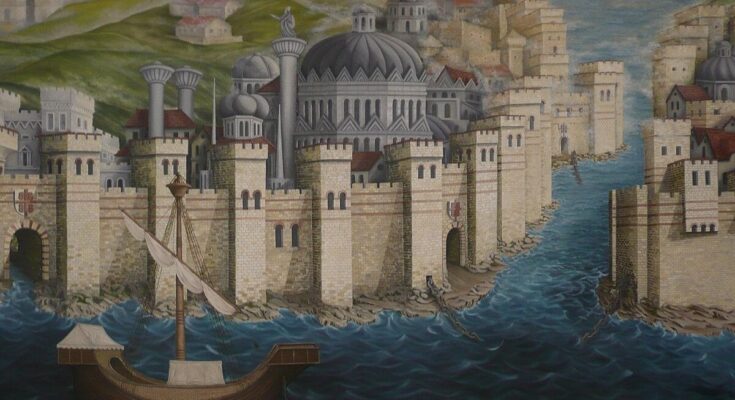Under Byzantine (Eastern Roman) rule, the inhabitants of Constantinople faced many threats. The Avars, Sassanids, Slavs, Crusaders, and Ottomans all laid siege to the legendary capital of the Eastern Roman Empire.
However, there was one threat lurking in the waters of the Bosporus that threatened sailors coming to and from the city that was not even human. During the sixth century AD, for about five decades, sailors in the waters around Constantinople lived in fear of a giant whale.
Porphyrios, as the whale was named, was infamous for attacking and even sinking ships in the waters around Constantinople. The whale became such a menace that Emperor Justinian I made capturing the beast an important priority.
Porphyrios: the whale that terrorized Constantinople
The main historical sources on Porphyrios come from Procopius, a sixth-century Byzantine historian. The whale is mentioned in two of Procopius’ works, History of the Wars and The Secret History.
For about fifty years, the infamous whale reportedly attacked sailors in the waters around Constantinople. Albeit, Porhyrios would sometimes disappear for extended periods, only to re-emerge and attack an unfortunate ship sailing near the Eastern Roman capital.
According to Procopius, Porphyrios would attack all manner of sea vessels, from small fishing boats to large merchant vessels and warships. Sailors were very understandably perturbed by reports of the whale attacks and would often take detours to avoid the waters Porphyrios was known to frequent.
What type of whale was Porphyrios?
According to the historians Sian Lewis and Lloyd Llewellyn-Jones, whales were not well understood in late antiquity, so the inhabitants of Constantinople likely believed that Porphyrios was a sea monster.
Identifying the exact species of whale that Porphyrios was is difficult. Based on Procopius’ account, Porphyrios was recorded to have a length of 13.7 meters (45 ft) and a width of 4.6 meters (15 ft).
Some propose that Porphyrios may have been a sperm whale due to its size, lengthy lifespan, and temperament. Others suggest it could have been an unusually large orca, considering its geographical location, as true whales seldom inhabit the waters frequented by Porphyrios.
There is also extensive debate surrounding the origin of the name for this infamous whale that harrassed the sailors of Constantinople.
One hypothesis suggests that it may be derived from the contemporary charioteer Porphyrius or the mythological giant Porphyrion, indicating the whale’s significance or power.
Another theory proposed by Anthony Kaldellis in 2010 suggests that the name alludes to the imperial purple, symbolizing the high regard in which the whale was held. Similarly, Sian Lewis and Lloyd Llewellyn-Jones believed that the name signifies royalty and evokes a sense of awe for the whale.
James Allan Stewart Evans, on the other hand, suggested in 1996 that the name refers to the color of the whale’s skin, possibly describing a deep purple hue. This interpretation was supported by John K. Papadopoulos, Deborah Ruscillo, and Daniel Ogden, who believed that “Porphyrios” simply means “purple” or “purple boy.” Kaldellis also endorsed this etymology in 2017.
The demise of Porphyrios
Porphyrios’ harassment of ships became such a problem that Emperor Justinian I was forced to address the issue, although he was unsure how to capture or kill the beast. Nevertheless, the threat of an apparently murderous whale lurking in the waters around Constantinople was clearly unwelcome, given how much maritime traffic passed through the imperial capital.
Eventually, the problem resolved itself. In the pursuit of a group of dolphins, Porphyrios beached itself at the mouth of the Black Sea. The whale wrestled to free itself but only succeeded in twisting itself further into the thick mud.
When news spread that the legendary whale had been beached, local inhabitants rushed out with axes to kill the beast. After slashing at Porphyrios for some time, their cuts proved ineffective as the axes barely pierced the whale’s flesh.
The Byzantines then hauled Porphyrios further out of the water with ropes and wagons where a second attempt at hacking the beached whale was successful. The whale was then divided into cuts of meat and consumed by the celebrating Byzantines or stored to be eaten later.
Procopius recorded that the whale’s death was met with a sense of relief by the inhabitants of Constantinople. Fishing vessels, warships, and merchant vessels laden with goods could finally sail to and fro the imperial capital without fear of attack… or could they? After the whale was slaughtered on the beach, there were some rumors that it had not been Porphyrios, but some other whale that had gotten itself killed. So, perhaps the infamous Porphyrios lived on.



